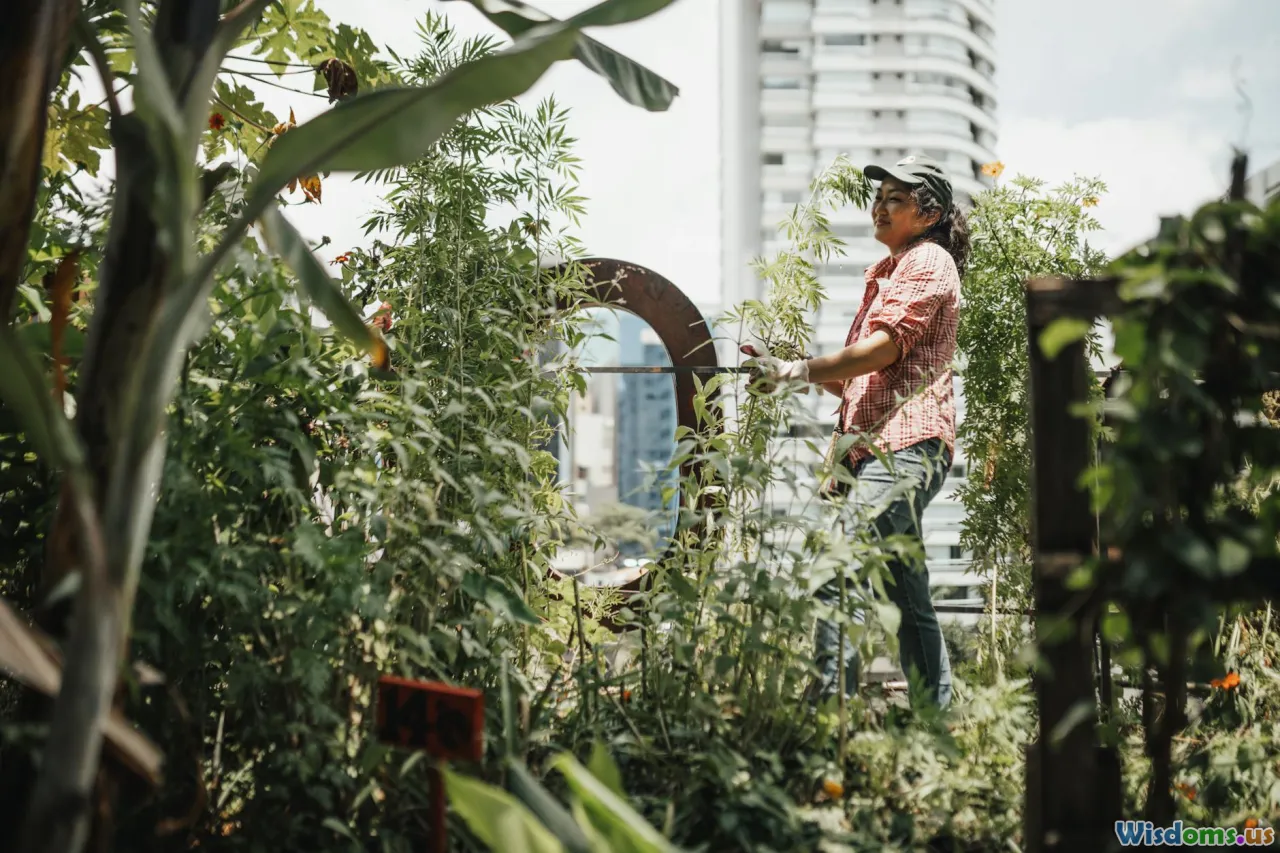
Urban Food Deserts How Rooftop Gardens Offer Hope
15 min read Explore how rooftop gardens are tackling urban food deserts, providing fresh produce and hope for underserved communities. (0 Reviews)
Urban Food Deserts: How Rooftop Gardens Offer Hope
Walk through many major cities today and you'll find fresh food is not always within reach, even in the world’s most prosperous neighborhoods. Skyscrapers and pavement can mask a pressing crisis: urban food deserts. These are communities, often low-income, where residents struggle daily to access affordable and nutritious foods. But amidst the concrete, a green revolution is sprouting overhead — rooftop gardens are rewriting the story of food security in our cities.
Understanding Urban Food Deserts

The seductive gleam of city lights often distracts from the nutritional darkness lying beneath. The United States Department of Agriculture (USDA) defines food deserts as parts of the country vapid of fresh fruit, vegetables, and other healthful whole foods, usually found in impoverished areas. According to a 2022 USDA report, about 19 million Americans reside in food deserts, with minorities and the working poor most affected. The Bronx in New York, South LA in California, and Chicago’s South Side are classic examples—thriving urban landscapes but with significant portions of the population living over a mile from the nearest supermarket.
The consequences radiate far beyond convenience. Studies repeatedly tie food deserts to higher rates of obesity, diabetes, and cardiovascular ailments. Junk food and fast-food chains frequently take the place of fresh grocers, sabotaging diets and perpetuating health disparities. Traditional solutions — like opening new supermarkets — are often derailed by high rent, supply chain issues, or insufficient incentives.
Why Rooftop Gardens? The Vertical Solution

If we can't fit farms horizontally, why not vertically? Rooftop gardens are engineered plots perched atop city infrastructure, growing everything from herbs to full-fledged crops. New York City alone boasts over 700 acres of rooftops — underused canvases primed for cultivation.
Urban rooftop gardens tackle food insecurity on multiple fronts:
- Proximity: Fresh produce grows right above, not miles away, slashing transportation and spoilage.
- Resource Efficiency: Leveraging rainwater, compost, and even captured CO₂ from city air, these gardens promote circular sustainability.
- Community Engagement: Rooftop farms often double as educational and community green spaces, bringing neighbors together and teaching urban agriculture skills.
A shining model is Brooklyn Grange in New York. It operates the world’s largest rooftop soil farms (spanning 140,000 sq ft across three buildings), producing over 100,000 pounds of organically-grown vegetables annually. Their fresh harvests supply local markets and restaurants, narrowing the health food gap between city dwellers.
Tackling Unique Urban Challenges

Establishing a vibrant green rooftop in the heart of a bustling city isn’t as straightforward as sowing seeds.
Structural Barriers and Building Codes
Cities have strict guidelines about weight, water drainage, and rooftop access. Retrofitting older buildings to support heavy soil, irrigation systems, and foot traffic requires significant investment. Extensive engineering assessments are non-negotiable; green roofs typically weigh 17–50 pounds per square foot when saturated. Some cities offer tax rebates or zoning bonuses for green roof installations—Chicago, for example, launched a program in 2003 that has since planted more than 500 green roofs.
Environmental Stresses
Traditional city roofs endure extreme sun, wind, and temperature swings. Solutions include selecting drought-resistant or native plant varieties, adding windbreaks, and installing drip irrigation systems. Creative measures like hydroponic growing—cultivating plants in nutrient-rich solutions without soil—can lighten loads and boost resilience.
Social and Economic Hurdles
Start-up costs are substantial. The Urban Food Jungle project in Atlanta estimated costs of up to $25 per square foot for a mid-sized rooftop garden. Funding sources blend private investment, city grants, non-profits, and crowdfunding. Engaging residents in communal ownership is key; projects like Chicago’s Pilsen Roof Top Garden hired local youth seasonal jobs, nurturing both plants and people.
Case Studies: Rooftop Gardens Flourishing Amid City Heights

Brooklyn Grange, New York City
Founded in 2010, Brooklyn Grange has transformed commercial-building roofs into thriving market gardens. Besides selling to top-tier NYC restaurants and farmers’ markets, they partner with City Harvest to donate thousands of pounds of surplus produce to local pantries. The farm hosts regular workshops for students and at-risk youths, tying agricultural literacy to urban survival.
The Rooftop Gardens Project, Montreal
Montreal’s Rooftop Gardens Project is a holistic model linking social housing residents to food education and actual garden beds. Volunteers and residents grow everything from strawberries to lettuce above three city buildings. Since 2003, they’ve yielded more than 5,000 pounds of vegetables year-round; the harvest supplements local food banks and strengthens fragile food systems.
Urban Harvest STL, St. Louis
Urban Harvest STL created the FOOD ROOF Farm atop a 7,500 square-foot warehouse. Over four years, it’s harvested over 15,000 pounds of food. Not only does it supply downtown residents but its gardens demonstrate resilient techniques like pollinator beds and rainwater collection. Its education programs reach more than 1,800 students annually, expanding food justice through hands-on learning.
How-To: Starting Your Own Rooftop Garden in the City

Transforming urban rooftops into gardens can feel daunting, but with careful planning, even small buildings can boost local food accessibility.
1. Assess Structural Viability
Before anything, consult a structural engineer. Many apartment and commercial roofs weren't designed for additional weight. If possible, seek buildings that already have green roof systems or flat, accessible surfaces.
2. Secure Permissions
Most urban areas will require permits. Engage your property owner or condominium board, and clarify insurance and liability responsibilities up front.
3. Design for Purpose and Resilience
Choose between systems:
- Container Gardens: Lightweight, movable, and simple to manage — ideal for first-time growers and rental buildings.
- Raised Beds: Deeper, allowing you to cultivate root vegetables.
- Hydroponics: Space-efficient and delivers higher yields in smaller footprints, facilitating year-round production indoors or atop roofs.
4. Harness the Community
A rooftop garden thrives with people power. Form a core team to divide watering, maintenance, and harvesting. Tap into local expertise — master gardeners or urban ag programs — to boost your skills.
5. Prioritize Sustainability
Establish rainwater collection systems and composting stations to minimize resource waste. Select native or locally-adapted crops to reduce water and fertilizer needs.
6. Embrace Education
Involve neighborhood schools for field trips, lessons, or summer camp connections. As Washington’s Walker Jones Urban Farm illustrates, when kids get involved, so do families, extending the garden’s reach into the entire community.
Rooftop Gardening Benefits Beyond Nutrition

Rooftop farming’s power isn't limited to food production — it radiates ancillary benefits throughout cities:
Cooling Urban Heat Islands
Green roofs reduce roof surface temperatures by as much as 30–40�F during peak heat, lessening the urban heat island effect. In Chicago, green roofs cut surrounding surface temperatures and aid the city’s drive to lower energy consumption.
Combatting Air Pollution & Supporting Biodiversity
Leafy canopies absorb CO₂ and trap particulate matter, cleaning the urban atmosphere. Bees and butterflies return, pollinating both rooftop crops and local greenspaces. In Toronto, citywide green roofs have been linked with a measurable uptick in pollinator diversity.
Improving Mental Health and Community Cohesion
According to a 2021 survey published in the Journal of Urban Health, urban gardening participants reported significant drops in stress and improved well-being versus non-gardening control groups. Rooftop gardens create new green social spaces where city dwellers can disconnect from digital distractions and foster new relationships.
Barriers to Scaling and Policy Solutions

Despite their potential, rooftop gardens occupy only a tiny fraction of viable roofs worldwide. Why?
- Policy Gaps: Few cities have mandates or tax incentives targeting food-oriented rooftop gardens.
- Lack of Awareness and Training: Many residents and building owners lack knowledge or misguidedly expect high maintenance and costs.
- Initial Investment: Upfront costs can scare off even interested parties, especially without public or non-profit support.
Forward-thinking cities are responding:
- Paris: In 2020, rolled out Parisculteurs — an ambitious plan to cover 100 hectares of roofs and walls with gardens/farms by 2020. Their laws now prioritize food-producing green roofs on new builds.
- San Francisco: Mandates that 15–30 percent of most new roofs be "living roofs."
- Toronto: The world's first city-level bylaw (2009) requiring green roofs on certain new constructions, backed by subsidy programs for retrofits.
Advocacy groups like the Urban Agriculture Collective of Charlottesville push cities to include rooftop farming in urban planning frameworks. Public-private partnerships, streamlined permitting processes, and education drives have proved instrumental in setting up and sustaining successful urban farms.
Actionable Tips for Advocates, Policymakers, and Citizens

-
Advocate for Anchor Institutions: Push universities, hospitals, and municipal buildings to install demonstration rooftop farms, setting visible precedents.
-
Leverage School Curriculums: Encourage K–12 partnerships with urban farms, integrating STEM and nutrition education.
-
Simplify Regulations: Lobby for reduced permit costs, expedited reviews, and accessible insurance for rooftop agriculture.
-
Financial Programs: Seek or propose city-backed grants, low-interest loans, and tax breaks for rooftop garden start-ups targeting food insecurity.
-
Share the Story: Use social media, community newsletters, and local events to keep the momentum and celebrate successes — visible projects inspire replication.
-
Connect with Broader Food Justice Movements: Partner with co-ops, mutual aid groups, and food pantries to scale distribution and volunteer impact.
A Greener, Healthier Urban Horizon

Rooftop gardens present a refreshing antidote to food inequality, their lush rows and teeming bees standing as proof of what’s possible even in the densest downtowns. Around the world, these urban oases put nutritious food within walking distance and reshape relationships with what — and where — we eat. As cities expand and the demands for sustainability become ever more urgent, fostering rooftop agriculture is no longer simply desirable — it is essential.
By elevating this movement, urban communities reclaim agency of their health, environment, and future prosperity. The next time you gaze up at a city skyline, imagine the future: gardens on every roof, giving hope where it was once hard to find, and nourishing tomorrow’s generation with each new harvest.
Rate the Post
User Reviews
Popular Posts




















